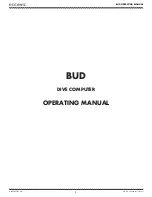
Information
Display
12
5.3
Power Up Checklist
We recommend you always go through this checklist before applying power to the Watt's
Up.
Always verify there are no exposed wires or bare connectors that can short circuit
prior to connecting a battery or power source to the Watt's Up.
Carefully inspect wire and connector insulation for damage or bare spots that can
short. Properly insulate any such areas with electrical tape or shrink tubing.
While a load connection is not required, ensuring that the LOAD wires are safely
routed is important to prevent shorts. Capping unused connectors with a fully insulated mating
connector as a "cap" is a useful trick. E.g. capping a female connector with an insulated male
connector.
CAUTION: Verify correct connection polarities before applying power or damage
may result!
5.4
Applying Power
The Watt's Up requires a power source providing a minimum of 4.0 V to operate. This can
come from a power source (battery or charger) on the LOAD or SOURCE side or from the
auxiliary 3-pin SOURCE power input connector.
If you connect an auxiliary power source of 4.0 V or more (e.g. small receiver battery
pack), the Watt's Up operates independently of power sources on the LOAD or SOURCE
leads. This allows measurements down to 0V, e.g. for measuring a single cell main pack.
Note that, for example, a standard 9 V alkaline battery can be wired to an auxiliary
connector and cable to be used as an auxiliary battery if desired.
5.4.1
Applying Power, Examples
Use at least a four cell NiCd or NiMH battery pack or a two cell Li-Poly battery
pack on the SOURCE side to provide the minimum 4.0 V. Connect a load on the LOAD side. E.g
an ESC and a MOTOR.
Connect an Auxiliary power source to the 3-pin SOURCE power input connector
and a single Li-Poly cell to the SOURCE side and an ESC and motor to the LOAD side.
5.4.2
Applying Power, Problems
When you apply power as described, the Watt's Up display will show the "Startup Screen"
and then begin measurements.
CAUTION: if the Startup Screen does not appear, immediately remove the power sources
and refer to the troubleshooting section of this document.
"Watt's Up" & "Doc Wattson" Watt Meter and Power Analyzer User's Manual
RC Electronics, Inc.















































